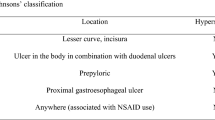Abstract
Background
There is great controversy regarding the choice of procedure for perforated duodenal ulcer patients. The purpose of this study was to compare the early outcome results of laparoscopic and open repair and to propose which risk factors influence the outcome.
Methods
Between October 1996 and May 2004, 60 patients underwent laparoscopic and 162 patients underwent open repair of perforated peptic ulcers in a tertiary care academic center. The results were retrospectively analyzed. The primary outcome measures included operative time, duration of hospital stay, morbidity, and mortality.
Results
The operative time was significantly longer in the laparoscopy group compared to the open repair group (76.2 ± 35.3 vs 57.3 ± 26.1 min, respectively). The hospital stay in surviving patients appeared to be significantly shorter after laparoscopy than after open repair (7.8 ± 5.3 vs 10.3 ± 10.6 days, respectively). Eight patients (13%) in the laparoscopic group and 41 patients (25%) in the open repair group had morbidity in the postoperative period. Suture leakage was confirmed in four patients (7%) following laparoscopic repair and in three patients (2%) in the open repair group. There were 20 deaths (9%), all in the open repair group.
Conclusions
Independent Boey risk factors, patient age, and large perforation size have a negative impact on patient recovery. Both laparoscopic and open repair are equally safe and effective in perforated duodenal ulcer patients with a Boey score of 0 or 1.
Similar content being viewed by others
References
Bergamaschi R, Marvik R, Johnsen G, Thoresen JE, Ystgaard B, Myrvold HE (1999) Open vs laparoscopic repair of perforated peptic ulcer. Surg Endosc 13: 679–682
Boey J, Choi SK, Poon A, Alagaratnam TT (1987) Risk stratification in perforated duodenal ulcers. A prospective validation of predictive factors. Ann Surg 205: 22–26
Druart ML, Van Hee R, Etienne J, et al. (1997) Laparoscopic repair of perforated duodenal ulcer. A prospective multicenter clinical trial. Surg Endosc 11: 1017–1020
Katkhouda N, Mavor E, Mason RJ, Campos GM, Soroushyari A, Berne TV (1999) Laparoscopic repair of perforated duodenal ulcers: outcome and efficacy in 30 consecutive patients. Arch Surg 134: 845–850
Lau H (2004) Laparoscopic repair of perforated duodenal ulcer: a meta-analysis. Surg Endosc 18: 1013–1016
Lau WY, Leung KL, Kwong KH, et al. (1996) A randomized study comparing laparoscopic versus open repair of perforated peptic ulcer using suture or sutureless technique. Ann Surg 224: 131–138
Lee FY, Leung KL, Lai BS, Ng SS, Dexter S, Lau WY (2001) Predicting mortality and morbidity of patients operated on for perforated peptic ulcers. Arch Surg 136: 90–94
Matsuda M, Nishiyama M, Hanai T, Saeki S, Watanabe T (1995) Laparoscopic omental patch repair for perforated peptic ulcer. Ann Surg 221: 236–240
Mehendale VG, Shenoy SN, Joshi AM, Chaudhari NC (2002) Laparoscopic versus open surgical closure of perforated duodenal ulcers: a comparative study. Indian J Gastroenterol 21: 222–224
Michelet I, Agresta F (2000) Perforated peptic ulcer: laparoscopic approach. Eur J Surg 166: 405–408
Naesgaard JM, Edwin B, Reiertsen O, Trondsen E, Faerden AE, Rosseland AR (1999) Laparoscopic and open operation in patients with perforated peptic ulcer. Eur J Surg 165: 209–214
Nathanson LK, Easter DW, Cuschieri A (1990) Laparoscopic repair/peritoneal toilet of perforated duodenal ulcer. Surg Endosc 4: 232–233
Robertson GS, Wemyss-Holden SA, Maddern GJ (2000) Laparoscopic repair of perforated duodenal ulcers. The role of laparoscopy in generalised peritonitis. Ann R Coll Surg Engl 82: 6–10
Seelig MH, Seelig SK, Behr C, Schonleben K (2003) Comparison between open and laparoscopic technique in the management of perforated gastroduodenal ulcers. J Clin Gastroenterol 37: 201
Siu WT, Chau CH, Law BK, Tang CN, Ha PY, Li MK (2004) Routine use of laparoscopic repair for perforated peptic ulcer. Br J Surg 91: 481–484
Siu WT, Leong HT, Law BK, et al. (2002) Laparoscopic repair for perforated peptic ulcer: a randomized controlled trial. Ann Surg 235: 313–319
So JB, Kum CK, Fernandes ML, Goh P (1996) Comparison between laparoscopic and conventional omental patch repair for perforated duodenal ulcer. Surg Endosc 10: 1060–1063
Author information
Authors and Affiliations
Corresponding author
Rights and permissions
About this article
Cite this article
Lunevicius, R., Morkevicius, M. Comparison of laparoscopic versus open repair for perforated duodenal ulcers. Surg Endosc 19, 1565–1571 (2005). https://doi.org/10.1007/s00464-005-0146-1
Received:
Accepted:
Published:
Issue Date:
DOI: https://doi.org/10.1007/s00464-005-0146-1



